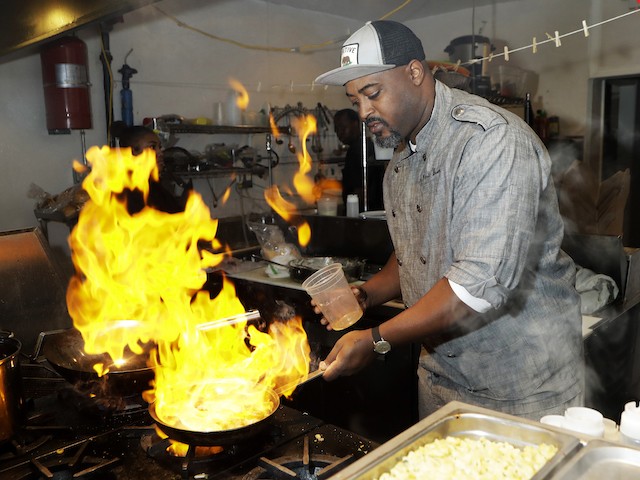THIS FUCKER LAWYER MAYORKAS FIGHTS TOOTH AND NAIL AGAINST E-VERIFY AND CAN'T OPEN HIS MOUTH WITHOUT MORE LIES COMING OUT ABOUT BIDEN'S INVASION.
REALITY IS THAT NAFTA JOE BIDEN HAS ALWAYS FOUGHT AGAINST THE AMERICAN WORKER!
Biden’s border chief, Alejandro Mayorkas, has already spent much of 2021 helping the CEOs and shareholders to re-inflate the cheap-labor bubble that hurt millions of Americans.
Since January, he has admitted at least 800,000 working-age migrants, and rolled back enforcement of U.S. labor law in abusive workplaces. The huge inflow has boosted the number of no-English speaking workers in Virginia and elsewhere.
Idaho feels impact of drug trafficking from border
https://www.youtube.com/watch?v=pFiTwBf6HwI
Gov. Abbott blasts Biden's 'catastrophic open border policies' for migrant crisis
Restaurant Execs: Less Migration Forces More Respect for American Employees

The shortage of migrants and willing Americans is forcing food-industry CEOs to treat their employees with more respect and dignity, says the personnel chief at one of the nation’s largest restaurant firms.
“You’ve got to be receptive to feedback,” Rick Badgley at Brinker International which owns the Chili’s Maggiano’s Little Italy restaurant chains, told an industry conference on October 13. He continued:
The workforce that we’re dealing with now has high standards, high demands, and high expectations. Make sure you’re investing the time to listen, listen to your team members, they have invaluable feedback for you.
Employees “have very distinct and really easy-to-follow motivators,” said Badgley told attendees at the conference, which was organized by food-delivery firm Doordash:
What we’ve experienced at the macro level down to the restaurant level, is that they [most] want flexibility with what has happened with what we call now the gig economy, the side hustle …
[And] compensation is important to everybody. What we’ve found through surveys and talking to our frontline employees, is that we need to align their compensation with their monthly bills.
Many food-industry companies hired workers under “at will” contracts where the employees do not know how many hours they will be scheduled to work each day. The contracts leave them with little ability to work other jobs, or even to arrange regular babysitting for their kids.
“Traditionally in restaurants, it was: ‘Hey, this is the job. If you want these hours, great; if not, we’ll find somebody else,’” Christopher Floyd, owner of a food-industry recruitment firm told the New York Times. “Now employers have to say, ‘You have the qualities we’re looking for; maybe we can work out a more flexible schedule that works for you.’

Customers dine at the Greek restaurant Molos in Weehawken, New Jersey on February 6, 2021, amid the coronavirus pandemic. (KENA BETANCUR/AFP via Getty)
Badgley’s recommendation comes amid widespread dissatisfaction by American restaurant workers, according to a September report by Black Box Intelligence, a firm that tracks the restaurant sector:
Most people agree higher pay is the main reason employees are leaving for other industries. Another driver is a need for a more consistent schedule and income. 51% of workers chose to work in restaurants because of flexibility, but beyond that flexibility, employees want some sense of consistency in terms of what their schedule might be and their income as a result.
“We don’t like to say this much, but it has long been the practice of many restaurants to hire staff as inexpensively as possible and provide them with the fewest benefits that they can, often by restricting their hours so they don’t qualify as full-time employees,” said Bret Thorn, the senior food & beverage editor for Nation’s Restaurant News. “We all know this,” he added:
I guess that can be a good business plan when the labor pool is deep, which it’s not now and I doubt will be for the foreseeable future, but it’s also cruel, and a growing number of people who have worked in restaurants now see that they can do better, and that they deserve better.
Legal and illegal migrant labor is commonplace and beneficial for business, partly because it minimizes the emergence of a wage-boosting tight labor market among American restaurant workers — or among their white-collar peers.
In August, for example, federal officials charged 19 co-defendants for allegedly running “an organized criminal enterprise from July 2003 to Aug. 10, 2021, that smuggled Mexican, Guatemalan, and El Salvadoran nationals who were not authorized to live or work in the United States.” The ring supplied many workers to at least 45 restaurants across the midwest.

In Detroit, River Bistro chef Maxcel Hardy prepares a Caribbean shrimp dish at his restaurant. The city allows chefs and prospective restaurant owners to realize their dreams at a lower financial cost than other places, like New York, according to chef Hardy. (AP Photo/Carlos Osorio)
Nonetheless, the poor wages and working conditions are a step up for many poor migrants, partly because they know that U.S. jobs may allow them to successfully launch their children into the United States.
“My parents came to the United States in the 1960s from Mexico … in search of a better life,” said Sen. Alex Padilla (D-CA) told an October 15 meeting with progressive lobbyists:
They weren’t blessed with a lot of formal education. My dad only had the opportunity to go to school for the first grade before stopping to work to help the family. My mom, we said, was the lucky one. She had a chance to finish elementary school, before doing the same. But they came to United States with a tremendous work ethic and big dreams. For 40 years, my father helped provide for our family by working as a short-order cook. And if you’re wondering what that means, if you’ve ever been out for breakfast, think of who’s scrambling eggs and flipping pancakes when you place an order. That’s what my dad did for 40 years. For the same 40 years, my mom used to clean houses. So, needless to say, it’s hard work, honest work, and and on those modest incomes they raised three of us.
But all that cheap labor made restaurant jobs miserable for many millions of poor Americans — and now they do not want to come back to the industry which treated them so badly.
In effect, exploitative executives drained their labor pool in the easy decades before Trump and the cor0navirus burst their cheap-labor bubble in 2020. Joblist.com, a job-finding site, reported in July 2021:
38% of former hospitality workers report that they are not even considering a hospitality job for their next position. These workers are transitioning out of the industry in search of a different work setting (52%), higher pay (45%), better benefits (29%), and more schedule flexibility (19%). Over 50% of former hospitality workers who are looking for other work say that no pay increase or incentive would make them return to their old restaurant, bar, or hotel job.
When industry executives raise wages to new hires, they also must raise the wages of their existing employees. The Wall Street Journal reported in August:
Chipotle Mexican Grill Inc. said in May that it was lifting its pay for hourly positions to an average of $15 an hour, amounting to an average raise of around $2 for front-line workers … The chain, which owns and operates its nearly 2,900 locations, made sure the raises included a premium for experienced employees within each role, and gave raises that averaged around $2 an hour to hourly managers and commensurate raises to salaried managers.
“Labor is substantially costing more now,” Hudson Riehle, the research director at the National Restaurant Association, told the Doordash conference:
You can see [on a chart] the average hourly earnings growth there coming out of the great recession …. currently running in excess of 6%. And for a typical restaurant operation, labor accounts about a third of the restaurant industry sales dollar. Food and beverage purchases [are] another third, and pre-tax income [profit] is generally just 3 to 6 percent. So there isn’t a lot of room of maneuverability for the operator to maintain their pretax profit margins. Consequently, margins are substantially under pressure in the industry for those operators that have survived.
Unsurprisingly, industry executives and stock-market analysts are pleading with Biden to re-inflate the cheap-labor bubble.
“We need immigration in our industry to have enough team members,” Domino’s Pizza’s CEO Ritch Allison told CNBC on October 15. Migrants “who want to work hard, want to stay with the business for a long period of time, can end up being owners and entrepreneurs,” he explained.
CNBC’s investment advisor, Jim Cramer, echoed the CEO’s demand for more imported workers:
Ritch Allison started, I think, a conversation that we’re all going to have to talk about. We don’t have population growth in this country. … But more importantly, he’s saying, we cut off immigration. We stopped it, but the great thing about our country is immigrants come in, they become drivers. Next thing you know they own a Domino’s, then they own several places. That’s ending. We literally have to start thinking about an immigration policy that involves taking in people.
Biden’s border chief, Alejandro Mayorkas, has already spent much of 2021 helping the CEOs and shareholders to re-inflate the cheap-labor bubble that hurt millions of Americans.
Since January, he has admitted at least 800,000 working-age migrants, and rolled back enforcement of U.S. labor law in abusive workplaces. The huge inflow has boosted the number of no-English speaking workers in Virginia and elsewhere.
But the near-term pressure is forcing food-industry CEOs to be nice to their American employees — and also to raise productivity and automate their workplaces.
“What are operators to do in an environment where they can’t find enough labor?” said Riehle. “They obviously raised the time that those workers … are working,” said.
“Consumers are seeking more technology in their restaurant experience,” he added. “They’re looking for it mainly in the ordering and payment making it easier to improve service to increase convenience … as well as expedite the experience.”
“We don’t see it getting any easier in the near future,” said Badgley, adding:
We are dealing with immigration laws. We’re dealing with the headwinds of wage inflation. We’re dealing with birth rates that are lower, we’re dealing with different generational demands, all of these things are upon us.
“What’s going on in the industry today … is historic.”
Cato: Donald Trump Excluded 1.2 Million Foreign Workers from U.S. Jobs

No comments:
Post a Comment